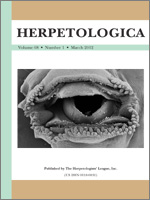Previous studies showed that Fejervarya cancrivora tadpoles were salt-tolerant (up to 24 parts per thousand [ppt] in the field and 35 ppt in the laboratory) but metamorphosed only at or below 6.6 ppt. We hypothesized that the discrepancy in salt tolerance of tadpoles is due to a mixture of results drawn from short- and long-term experiments and different acclimation procedures, which needed to be re-examined. We compared the salinity tolerance of acclimated and nonacclimated tadpoles and assessed salinity effects on growth, development, and metamorphosis among tadpoles of F. cancrivora throughout larval period. In Experiment 1, we determined 48-h tadpole survivorship by assigning 40 tadpoles to one of the 24 treatments ranging from 3-ppt to 30-ppt salinity. In Experiment 2, we assigned tadpoles to 3–15-ppt salinity at intervals of 3 ppt and monitored tadpole growth and development through metamorphosis. In Experiment 3, we exposed 15 tadpoles to a stepwise increase of salinity (i.e., 2 ppt every 3 d) and monitored the tadpole survivorship and metamorphic success. From Experiment 1 we estimated an LC50 (defined as the salt concentration that kills 50% of tadpoles within 48 h) of 13.7 ppt and tadpoles survived for 48 h at salinities as high as 16 ppt, suggesting that saline tolerance of F. cancrivora tadpoles is greater than all anuran species studied to date. Results of Experiment 2 showed that only tadpoles in 3, 6, and 9 ppt survived and reached metamorphosis. Tadpoles at 9 ppt grew and developed slower than in lower salinities during the first 7 wk, but the time to and size at metamorphosis were similar among treatments, suggesting that tadpoles were stressed at 9 ppt early, but they probably were able to maintain physiological homeostasis and to catch up growth after a period of adjustments. Results of Experiment 3 showed that all tadpoles survived through 18 d as the salinity was increased stepwise from 3 ppt to 15 ppt, and 6 out of 15 tadpoles were able to metamorphose at high salinities (17–21 ppt). This finding contradicts earlier results suggesting tadpoles could metamorphose only at salinities ≤6.6 ppt. Overall, our results showed that F. cancrivora tadpoles not only tolerate salt well, but also are capable of acclimation to higher salinities. This ability to acclimate could free tadpoles from dependence on the occurrence of rain to facilitate metamorphosis and thus, represents an adaptation to the unpredictable nature of salinity variation in brackish habitats.
BioOne.org will be down briefly for maintenance on 17 December 2024 between 18:00-22:00 Pacific Time US. We apologize for any inconvenience.
How to translate text using browser tools
1 March 2012
Salinity Acclimation Affects Survival and Metamorphosis of Crab-eating Frog Tadpoles
Wan-Tso Hsu,
Chi-Shiun Wu,
Jou-Chiieh Lai,
Yi-Kai Chiao,
Chih-Hao Hsu,
Yeong-Choy Kam
ACCESS THE FULL ARTICLE

Herpetologica
Vol. 68 • No. 1
March 2012
Vol. 68 • No. 1
March 2012
acclimation
amphibian
development
salinity stress
survivorship




